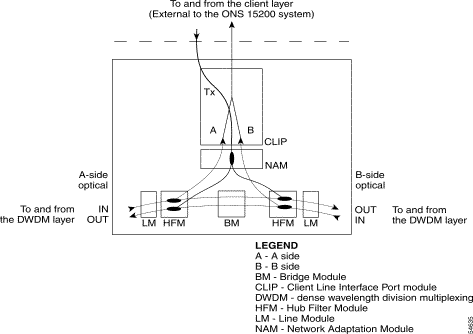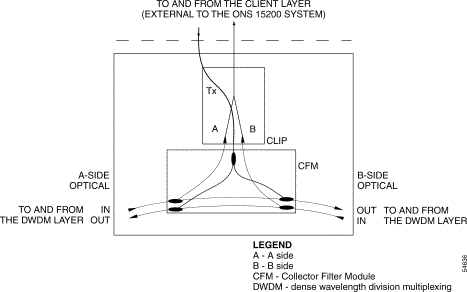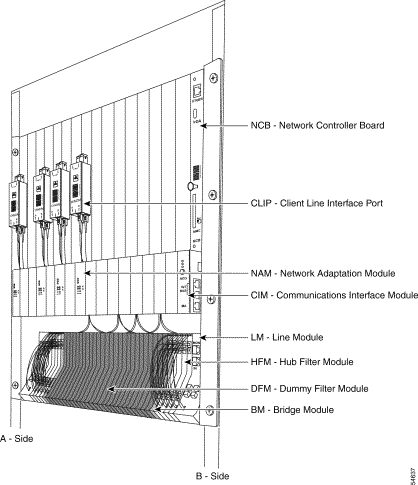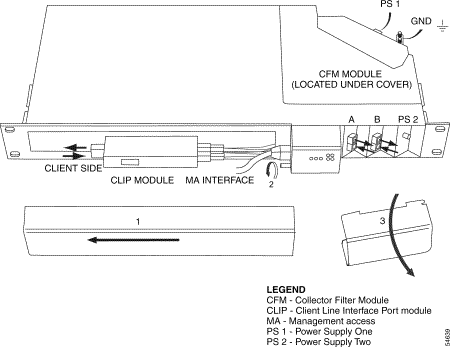|
|

This chapter describes the Cisco ONS 15200 mechanical components. It also provides electrical, electromagnetic, and safety information about the ONS 15200.
Equipment in the ONS 15200 system is modular in design. Each system function is carried out by modules located in either an ONS 15252 MCU or an ONS 15201 SCU. Sites in the ONS 15200 system consist of either an ONS 15252 MCU, an ONS 15201 SCU, or a combination of the two. Additionally, a power distribution panel (PDP) may be included in ONS 15200 site configurations.
The ONS 15252 MCU communicates with the other network elements (NEs) in the ONS 15200 system on one or several channels. Each channel occupies a wavelength, but in some ONS 15200 system configurations, the wavelengths can be reused. As shown in Figure 3-1, several channels of information, each occupying a wavelength, enter the NE from the DWDM layer. Each channel of information can enter the ONS 15252 MCU from the A side, the B side, or the A side and B side.
The ONS 15252 MCU communicates with the other network elements in the ONS 15200 system on one or several wavelengths. Information originating at the ONS 15252 MCU Client Layer Interface Port (CLIP) module is split by the Network Adaptation module (NAM) and transmitted in opposite directions through two different pairs of Hub Filter modules (HFMs) and a Line module (LM) at a specific wavelength for fiber-protected channels. For unprotected channels, the NAM module directs the channel to an A-side HFM module or a B-side HFM module. The unprotected channel is then transmitted through the associated LM. Information carried on a wavelength intended for another ONS 15200 site will pass through the ONS 15252 MCU without interference except for the insertion loss of the ONS 15252 MCU (Figure 3-1). If the ONS 15252 MCU is equipped with Termination modules (TMs) instead of a BM, the TM will block any wavelength or channel not dropped to the ONS 15252 MCU.

Two versions of the ONS 15252 MCU mechanical shelf exist: Release 1.0 and Release 1.01. Cisco currently ships only the Release 1.0.1 shelf and no longer ships the Release 1.0 shelf.
The Release 1.0.1 shelf includes a baffle. The baffle is a partially-perforated, angled metal plate that is mounted below and behind the metal support beam and is mechanically attached to the back of the shelf. It runs the width of the shelf. To view the baffle, look up through the ventilation cavities at the back of the shelf.
The ONS 15252 Release 1.01 includes a fan unit. Before using the Release 1.01 shelf, you must install the fan unit. Do not use the fan unit with a Release 1.0 shelf. See the "Fan Unit" section for more information about the fan unit.
 |
Caution You must install the fan unit in a Release 1.01 shelf. Running the Release 1.01 shelf without the fan unit may result in equipment damage. |
 |
Caution Do not install the fan unit in a Release 1.0 shelf. Running the Release 1.0 shelf with a fan unit may result in equipment damage. |
The ONS 15252 Release 1.01 includes an updated Network Adaptation Module (NAM). The Release 1.01 NAM is designated with a "N3"label on the faceplate, whereas the previous version of the NAM does not have a faceplate label. The Release 1.01 shelf requires the Release 1.01 NAM. You can also use Release 1.01 NAMs in the Release 1.0 shelf. See the Cisco ONS 15200 Module Handbook for more information about the NAM.
 |
Caution Placing NAMs without the N3 label into an Release 1.01 shelf may result in equipment damage. |
The ONS 15201 SCU communicates with the other network elements in the ONS 15200 system on a specific wavelength or channel. From the DWDM layer, several channels of information, each occupying a wavelength, enter the ONS 15201 SCU. Each DWDM channel of information can enter the ONS 15201 SCU from the A side, the B side, or the A side and B side.
The specific channel or wavelength intended for the ONS 15201 site will be dropped and transferred to the CLIP module by the Collector Filter module (CFM). The channel will be dropped from the A side and B side for protected channels and from the A side or B side for unprotected channels. For protected channels, information originating at the ONS 15201 will be transferred from the CLIP module to the CFM module, split by the CFM, and transmitted at a specific wavelength or channel in opposite directions on the A side and B side. Unprotected channels are not split, but are directly transmitted to the A side or B side. Information carried on a wavelength or channel intended for another ONS 15200 network element will pass through the ONS 15201 SCU without interference except for the insertion loss caused by the unit (Figure 3-2).

A power distribution panel (PDP) can be included in ONS 15200 site configurations. The PDP distributes power to the ONS 15200 site and provides current protection. It uses input and output fusing to provide system protection.
All ONS 15252 MCU site configurations must have a fan unit mounted above the ONS 15252 MCU in the equipment rack. The fan unit contains eight small fans that are run in parallel at constant speed. The fans push air down through the MCU to cool the Client Layer Interface Port (CLIP) modules. The fan unit is powered by its own two -48 VDC power inlets independently of the MCU. If the fan unit fails, it generates an alarm to indicate multi- or single-fan failure. Located on the front panel of the fan unit are three LEDs to indicate alarm status. Table 3-1 lists the LED status and cause of alarm.
| LED | Status | Cause |
|---|---|---|
Red | Major alarm | Multi-fan failure |
Yellow | Minor alarm | Single-fan failure and/or single 48 V failure |
Green | Normal | Power on |
The Release 1.01 shelf requires a fan unit, as described in the "ONS 15252 MCU" section. Do not use a fan unit in a Release 1.0 shelf.
 |
Caution You must install the fan unit in a Release 1.01 shelf. Running the Release 1.01 shelf without the fan unit may result in equipment damage. |
 |
Caution Do not install the fan unit in a Release 1.0 shelf. Running the Release 1.0 shelf with a fan unit may result in equipment damage. |
The fiber organizer allocates distribution of the client optical-fiber cables to the ONS 15252 MCU CLIP modules. Additionally, the fiber organizer provides tension relief for the client optical fiber cables. A fiber organizer can also be installed between additional ONS 15252 MCUs or ONS 15201 SCUs located at a site. A fiber organizer is always included with an ONS 15252 MCU.
Two power supplies are included in ONS 15201 SCU site configurations. The power supplies convert AC to DC and provide a regulated -48 VDC to the ONS 15201 SCU.
This section describes the physical configuration of the ONS 15252 MCU and ONS 15201 SCU.
The ONS 15252 MCU physical configuration consists of a Network Control Board (NCB) module, Network Adaptation modules (NAMs), a Communication Interface module (CIM), Client Layer Interface Port (CLIP) modules, Hub Filter modules (HFMs), a pair of Line modules (LMs), and one Bridge module (BM) (see Figure 3-3). A pair of Termination modules (TMs) can be used in place of the BM when all optical signal channels or wavelengths are dropped at the ONS 15252 MCU. Additionally, when multiple ONS 15252 MCUs are interconnected, Connection Module X (CMX) and/or Connection Module Y (CMY) are used in place of the BM. The type of connection module used depends on the specific ONS 15200 system configuration.

The lower portion of the ONS 15252 MCU is referred to as the passive optical shelf. The passive optical shelf has an A side and B side. The A side of the ONS 15252 MCU is located on the left side of the passive optical shelf, as seen from the front. The A-side LM contains one line IN port, one line OUT port, and two line-monitoring ports of either SC (standard) or FC (optional) type. The line-monitoring ports make it possible to monitor the A-side incoming and outgoing DWDM optical signals.
The B side of the ONS 15252 MCU is located on the right side of the passive optical shelf, as seen from the front. The B-side LM contains one line IN port, and one line OUT port, and two line-monitoring ports of either SC (standard) or FC (optional) type. The line-monitoring ports make it possible to monitor the B-side incoming and outgoing DWDM optical signals. Additionally, the passive optical shelf contains the A-side and B-side HFMs and TMs, BMs, CMXs, or CMYs in various combinations. Figure 3-4 shows the typical arrangement of the modules in the passive optical shelf.

The ONS 15201 SCU physical configuration consists of a CLIP module and a CFM (Figure 3-5). The A side of the ONS 15201 SCU is the two far-left optical line connectors on the front or back of the ONS 15201 SCU. The B side of the ONS 15201 SCU is the two far-right optical line connectors on the front or back of the ONS 15201 SCU. The ONS 15201 SCU is normally delivered with optical connections on the front (SC type). Optionally, the ONS 15201 SCU can be ordered with the optical connections on the back of the unit. FC connectors are always on the back of the unit. Back placement is optional for SC connectors.
 |
Note The ONS 15201 SCU can be ordered with optical connectors located on either the front or the back but not on both. |

This section describes power and grounding for the ONS 15200 system unit and includes the"ONS 15252 MCU Power and Grounding" section and the "ONS 15201 SCU Power and Grounding" section. The grounding connections for the ONS 15201 SCU and the ONS 15252 MCU are shown in Figure 3-6.

Two power supply connectors are located on the backplane of the ONS 15252 MCU. The far-right power connector (as viewed from the rear of the ONS 15252 MCU) is called PS-1 (power supply one), and the far-left power connector is called PS 2 (power supply two), as shown in Figure 3-6. The PS-1 and PS-2 power supply connector terminals are designated 0V and -48V. Grounding for the ONS 15252 MCU chassis is provided by two lug-type grounding connectors (Figure 3-6).
 |
Note To prevent ground loops, use only one grounding connector. |
The fan unit back panel has two power supply connectors. The far-right power connector (as viewed from the rear of the fan unit) is the primary source, and the far-left power connector is the secondary source. These power connectors are designated as 0V and -48V. A pair of grounding pins (M4 screws) is located beside each of the power connectors on the fan-unit back panel.
Two supply connectors are located on the ONS 15201 SCU chassis. The power supply located on the front of the ONS 15201 SCU chassis is labeled PS-2 (power supply two), and the power supply connector located on the backplane of the ONS 15201 SCU chassis is labeled PS-1 (power supply one) (Figure 3-5). Grounding for the ONS 15201 SCU chassis is provided by lug-type grounding connectors located on the back of the chassis.
The ONS 15252 MCU is compliant with Network Element Building Systems (NEBS) Level 3 of Telcordia SR-3580 and applicable sections of Telcordia GR-63-CORE and Telcordia GR-1089-CORE. Additionally, the ONS 15200 system is compliant with ETS 300 019-1-1 (class 1.1), ETS 300 019-1-2 (class 2.3), and ETS 300 019-1-3 (class 3.1) for environmental requirements.
The ONS SCU 15201 is compliant with Network Element Building Systems (NEBS) Level 2 of Telcordia SR-3580 and applicable sections of Telcordia GR-63-CORE and Telcordia GR-1089-CORE. Additionally, the ONS 15200 system is compliant with ETS 300 019-1-1 (class 1.1), ETS 300 019-1-2 (class 2.3), and ETS 300 019-1-3 (class 3.1) for environmental requirements.
The ONS 15200 system is compliant with Telcordia GR-1089-CORE and FCC Part 15 specifications for electromagnetic compatibility for NEBS Level 2. Additionally, the ONS 15200 system is complaint with ETS 300 386-1, class 1 and 2 for electromagnetic compatibility.
This section provides the ONS 15200 system laser and product safety specifications.
The ONS 15200 system is compliant with IEC-60825-1, IEC 60825-2, and CFR 1040.10 requirements for laser safety.
The ONS 15200 system equipment complies with the product safety requirements in European Norm (EN) 60 950 and Underwriters Laboratory (UL) 1950. In addition, the equipment adheres to the European Union (EU) low voltage directive LVD 73/23/ECC.
The ONS 15200 system adheres to 200 GHz wavelength spacing and the wavelengths defined in the specification ITU-T G.692.
![]()
![]()
![]()
![]()
![]()
![]()
![]()
![]()
Posted: Mon Sep 30 20:44:10 PDT 2002
All contents are Copyright © 1992--2002 Cisco Systems, Inc. All rights reserved.
Important Notices and Privacy Statement.